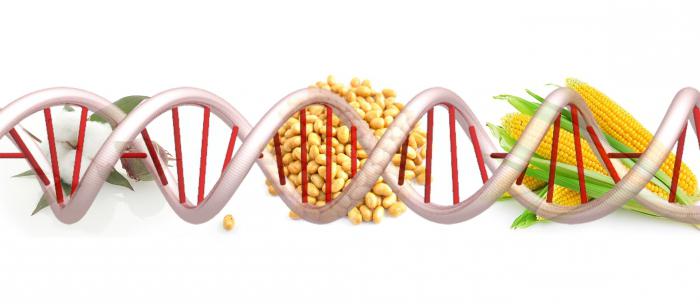The theme of this article is "GMOs: benefit or harm?". Let's try to understand this issue impartially. After all, it is precisely the lack of objectivity that many materials today address on this controversial topic. Today, in many countries of the world (including Russia), the concept of GMO has come to be used when they talk about "products that cause tumors and mutations." From all sides, GMOs are being poured with mud for various reasons: tasteless, unsafe, threaten the food independence of our country. But are genetically modified foods so scary and what is it really like? Let's answer these questions.
Deciphering the concept
GMOs are genetically modified organisms, that is, modified using genetic engineering methods. This concept in the narrow sense applies to plants. In the past, various breeders, like Michurin, have achieved plant benefits using a variety of tricks. These included, in particular, grafting the cuttings of some trees to others or the choice for sowing seeds with only certain qualities. After that, it was necessary to wait a long time for the results, which only after a couple of generations persistently manifested. Today, the right gene can be moved to the right place and thus quickly get what you want. That is, GMOs are the direction of evolution in the right direction, its acceleration.
Original goal of GMO breeding
The goal of GMO removal was initially to increase the yield of various plants, increase their resistance to adverse factors (lack of nutrients, drought), the emergence of insensitivity to viruses, and unattractiveness for parasite insects. In other words, the scientists wanted to get plants that at a minimum cost could grow, give high yields and thus solve the food problem. And this question is acute today in many countries of the world. This is the main goal pursued by genetic engineering and biotechnology, creating GMOs.
How are GMOs created?
Several techniques can be used to create a GMO plant. The most popular today is the transgenic method. The necessary gene (for example, the drought resistance gene) for this is isolated in pure form from the DNA chain. After that, it is introduced into the DNA of the plant, which must be modified.
Genes can be taken from related species. In this case, the process is called cisgenesis. Transgenesis occurs when a gene is taken from distant species.
It is about the last that terrible stories go. Many, having learned that wheat exists today with the scorpion gene, begin to fantasize about whether claws and tail will grow in those who eat it. Numerous illiterate publications on forums and sites add fuel to the fire. Today, the topic of GMOs, the benefits or harms of which are being circulated very actively, has not lost its relevance. However, this is not the only thing that “specialists”, new to biochemistry and biology, scare potential consumers of products containing GMOs.
GMO foods
Today, they agreed to call such products all that are genetically modified organisms or any products that contain components of these organisms. That is, GMO food will be not only genetically modified potatoes or corn, but also sausages, in which GMO soy is added in addition to liver and sodium nitrate . But products from cow meat that were fed wheat containing GMOs will not be considered such a product.
The effect of GMOs on the human body
Journalists who do not understand topics such as genetic engineering and biotechnology, but understand the relevance and relevance of the problem of GMOs, launched a duck that, getting into our intestines and stomach, the cells of their products are absorbed into the bloodstream and then spread to tissues and organs in which cause cancerous tumors and mutations.
It has to be noted that this fantastic plot is far from reality. Any food, without or with GMOs, in the intestines and stomach breaks down under the influence of intestinal enzymes, the secret of pancreatic and gastric juice into its components, and they are not genes or even proteins at all. These are amino acids, triglycerides, simple sugars and fatty acids. All this at different parts of the gastrointestinal tract is then absorbed into the bloodstream, and then consumed for various purposes: to obtain energy (sugar), as a building material (amino acids), for energy reserves (fats).
For example, if you take a genetically modified organism (for example, an ugly apple that looks like a cucumber), then it will be easily chewed and decomposed in the same way as any other without GMOs.
Other GMO horror stories

Another bike, no less chilling, concerns the fact that transgenes are built into the human genome , which leads to terrible consequences like infertility and cancer. For the first time in 2012, the French wrote about cancer in mice that were given genetically modified grain. In fact, Gilles-Eric Seralini, the head of the experiment, made a sample of 200 Spreg-Dowley rats. Of these, a third were fed GMO corn corn, another third were genetically modified corn treated with the herbicide, and the last was fed with ordinary grains. As a result, female rats that consumed genetically modified organisms (GMOs) gave tumor growth of 80% over two years. The males, on the other hand, earned renal and hepatic pathologies on this diet. It is characteristic that on ordinary food a third of the animals also died from various tumors. This line of rats is generally prone to the sudden appearance of tumors, not associated with the nature of the diet. Therefore, the purity of the experiment can be considered doubtful, and it was recognized as insolvent and unscientific.
Similar surveys were carried out earlier, in 2005, in our country. GMO in Russia was studied by biologist Ermakova. She presented at a conference in Germany a report on the high mortality of mice fed GMOs. The statement confirmed in a scientific experiment then began to spread throughout the world, bringing young mothers to hysteria. After all, they had to feed their babies with artificial mixtures. And they used GMO soy. Five experts of Nature Biotechnology subsequently agreed that the results of the Russian experiment are ambiguous, and its reliability was not recognized.

I would like to add that even if a piece of foreign DNA is in the bloodstream of a person, this genetic information will not be integrated into the body in any way and will not lead to anything. Of course, in nature there are cases of incorporation of pieces of the genome into a foreign organism. In particular, some bacteria thus spoil the genetics of flies. However, similar phenomena have not been described in higher animals. In addition, there is more than enough genetic information in products without GMOs. And if they have not been embedded in human genetic material so far, then you can continue to calmly eat everything that the body absorbs, including one containing GMOs.
Benefit or harm?
Monsanto, an American company, already in 1982 brought to the market genetically modified products: soy and cotton. She also owns the authorship of the killer of all vegetation, with the exception of the genetically modified herbicide Roundup.
In 1996, when Monsanto’s products were launched into the markets, corporations competing with it launched a large-scale campaign to save revenue, aimed at limiting the circulation of GMO-containing products. The first to be persecuted was Arpad Pustai, a British scientist. He fed GMO potatoes to rats. However, subsequently experts all the calculations of this scientist smashed to smithereens.
Potential harm to Russians from GMO products
No one hides that on sown GMO-grain lands nothing ever grows again, except for themselves. This is due to the fact that cotton or soybean varieties resistant to herbicides do not stain them. Thus, they can be sprayed, achieving extinction of the rest of the vegetation.
Glyphosphate is the most common herbicide. In fact, it is sprayed even before the plants ripen and quickly decomposes in them, not being preserved in the soil. However, resistant GMO plants allow it to be used in large quantities, which increases the risks of glyphosphate accumulation in GMO vegetation. It is also known that this herbicide causes bone proliferation and obesity. And in Latin America and the United States, there are too many people who are overweight.
Many GMO seeds are designed for only one sowing. That is, the offspring will not give what grows out of them. Most likely, this is a commercial trick, because in this way the marketing of GMO seeds is increased. Modified plants, giving the next generation, perfectly exist.
Since artificial mutations of genes (for example, in soy or potato) can increase the allergenic properties of products, it is often said that GMOs are powerful allergens. But some varieties of peanuts lacking the usual proteins do not cause allergies, even for those who have suffered with it earlier on this product.
Due to the characteristics of pollination, GMO plants can reduce the number of other varieties of their species. If ordinary wheat and GMO wheat are planted at two sites adjacent, there is a risk that the modified one will supersede the ordinary one by pollinating it. However, hardly anyone would let them grow nearby.
Having abandoned their own sowing funds and using only GMO seeds, especially disposable ones, the state will ultimately become in food dependence on the companies that hold the seed fund.
Conferences with the participation of Rospotrebnadzor
After horror stories and tales about GMO products were repeatedly disseminated in all mass media, Rospotrebnadzor participated in many conferences on this issue. At a conference in Italy in March 2014, his delegation participated in technical consultations on the low content of genetically modified organisms in Russia's trade. Today, therefore, a course has been adopted towards the almost complete prohibition of such products on the food market of our country. The use of GMO plants in agriculture was also delayed, although the use of GMO seeds was planned to begin in 2013 (government decree of September 23, 2013).
Barcode
The Ministry of Education and Science went even further. It proposed the use of a barcode replacing the mark “Does not contain GMOs” in Russia. It should contain all information about the genetic modification contained in the product or its absence. A good start, but without a special device it will be impossible to read this barcode.
Genetically Modified Products and the Law
GMOs are regulated by law in some states. In Europe, for example, their content in products is not allowed more than 0.9%, in Japan - 9%, in the USA - 10%. In our country, products in which the content of GMOs exceeds 0.9% is subject to mandatory labeling. For violation of these laws, enterprises face sanctions, up to the termination of activity.
Conclusion
The conclusion from all this can be drawn as follows: the problem of GMOs (the benefits or harms of using the products containing them) is clearly bloated today. The real consequences of the long-term use of such products are unknown. To date, authoritative scientific experiments on this issue have not been conducted.